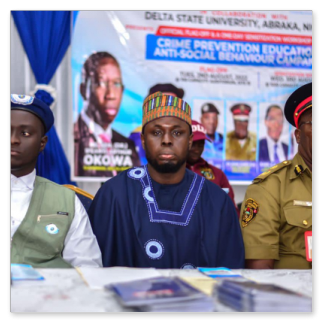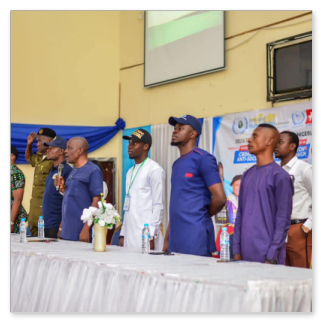IHRC: THE CRIME PREVENTION EDUCATION
Missions > Actions > Crime Prevention Education
BEING AN ADDRESS PRESENTED BY FIDELIS ONAKPOMA, IHRC EDITOR-IN-CHIEF For AFRICAN COUNTRIES AT THE OFFICIAL FLAG-OFF OF THE CRIME PREVENTION EDUCATION AND ANTISOCIAL BEHAVIOR CAMPAIGN, AT DELTA STATE UNIVERSITY ABRAKA.
TUESDAY 2ND AUGUST, 2022.
Protocols.
I want to welcome everyone who honoured our invitation to this event. Youth face many challenges that make them vulnerable to crime, violence, and victimization, and it is key that their development is supported so that they can positively contribute to society. Criminal activities short-chains the realization of the goals and objectives of education (Ali, Dada, Isiaka & Salmon, 2014). Today, I will briefly emphasize on the Project's goal, focus, and objectives.
The Project Goal is a planned effort that seeks to reduce the risk of crime occurrence and their harmful effects on individuals, and society; providing guidelines for crime prevention and anti-social behaviors by creating distinct campaigns that educate young people and instill moral values.
Our focus is on certain aspects of education that are meant to cultivate critical thinking skills among youth and build an awareness that crime is bad and harmful to society. This, in turn, should inspire individuals to abstain from criminal activities and also instill support for societal efforts to prevent and address all types of crime. As well as teaching on issues related to the United Nations Office On Drugs and Crimes (UNODC)-mandated areas will be facilitated and promoted, including corruption, organized crime, trafficking in persons, smuggling of migrants, terrorism, cybercrime, criminal justice, and arms trafficking, as well as on integrity and ethics.
Objectives are:
-Developing and resourcing national/state plans and policies to address factors that promote criminal activities and proffering a lasting remedy.
-Break the culture of silence and increase the level of collective participation in curtailing crimes and conflict resolutions.
-Increase awareness of these issues with the use of the observatory platform.
-Facilitate and support opportunities for crime prevention and other associated vices commonly found among young people.
-To abolish the several dangerous assumptions about the role, position, and contribution of youths seen as potentially dangerous ‘subjects’ and policy approaches often regard them as a problem.
-To develop and build collaboration among stakeholders to ensure the culture of peace and lawfulness is possibly attained without restrictions.
-What should be done:
Therefore we must come together to find ways to engage as directly and forcefully as possible, strengthen the approaches that work, chart new paths and sustain new partnerships in transforming policy into action.
1. By the Government: They have a key role in developing overall policies, and in promoting, coordinating and supporting crime prevention, regardless of their political-administrative structures or stage of economic development. Thus national Governments, State and local governments all have significant opportunities and roles to play.
2. By Stakeholders: Stakeholders which are highly knowledgeable technocrats and skilled professionals needed to show greater interest in the issue of crime prevention to deepen quality impact.
(More participatory actions are contained in our Institutional Framework).
Thank you.
Fidelis Onakpoma (FIICEP)
IHRC Editor-in-chief for African Countries.






